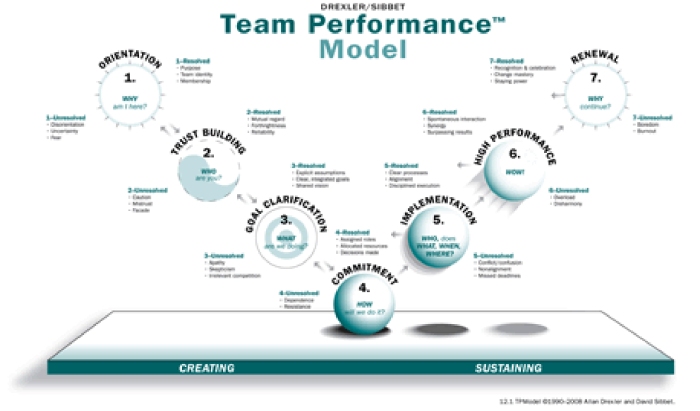
A Story From the Balcony: Group Dynamics | Part 3
The Ideal
Based on the Drexler/Sibbet Model, we went from stage one—orientation—to completing the task without entering the intervening stages. I believe this is usually the case where groups form around short-term projects. The stages required to build trust take time and respect for all ideas.

We did not clearly identify problems, and most importantly, communicate a common vision for the group. A consensual agreed upon structure would have defined the group further and helped develop group norms. Limited time and the need for creativity make different approaches that, in essence, bond people.
A common vision is paramount to jump-starting any process of building a relationship or starting any project. The other paramount ingredient is the respect for all ideas. The notion of respect for all ideas is essential to keep all stakeholders at the table lest the table become singular. The above two elements, along with feelings of connectedness, bring transformation with multi-perspectives–the essence of innovation. This encompasses the IDEO model and more. An idea that may sound weird, when flushed out a bit, usually spurs other ideas; suddenly, we are adaptive, thinking of outside-the-box, real, creative ideas.
I disagree with the Drexler/Sibbet model, which notes that trust comes before goal clarification, because people need solid reasons to gather and take time out of their schedule — making the framing of goals or intentions very important for getting stakeholder buy-ins. That allows for interactions that, if positive, will lead to trust and relationship building. This strengthens stakeholders’ commitment. A clear vision lends itself to prioritizing goals and aligning them with resources.
When all ideas are acknowledged and discussed, the end result can be creative and innovative. This is facilitated by focusing on common visions whilst anticipating conflict. If a conflict is handled with respect and inquiry, the result will be high-performing teams (or communities) with innovative ideas.
Given the pressure and discomfort with the topic at hand, our class overlooked the above. In my opinion, we went from the task to the solution without understanding the problems. My attempts to understand the problems and the right questions were met with fierce resistance. In my mind, how could we begin to tackle an adaptive problem without understanding the perspectives of the afflicted communities and their families? There were basic questions that were never answered. These include:
a) What were some explanations for the large disparity in infection rates between black females and black males?
b) Why was the ratio of sexually active black teenagers similar to white teenagers, while Chlamydia infection rates between the two groups were disproportionately out of whack against black teens? (Sexual activity rate is similar between black and white teens while chlamydia infection rates are much higher in black teenagers than white teenagers. Why? How was chlamydia reduced in white teens?) Those questions were basic research questions that suggested other factors were at play, and that Prof Wang’s lecture did have relevance beyond due mention of the subject matter.
Other questions best answered by communities follow. The process of discovering the many narratives behind those questions often lead to trust, better partnerships and collaborative efforts:
a) What were the trusted communication sources within this population? How was information transferred?
b) What were the demographics and cultural dynamics of these communities?
c) What were the access issues to treatment?
d) If the stigma of STD was the sole factor for not seeking care, why did many other cities seek onsite testing?
e) What was the standard of care when sexually active teens presented for a physical? What was it when they presented for screening or an STD? How did those standards compare to non-disadvantaged communities?
f) Were their other medical problems with such racial disparity? These were important questions; unfortunately, I was ineffective in articulating them. Soon, many of my classmates stopped listening the moment my mouth opened.
The Conclusion
Were my actions adaptive? Did I exercise adaptive leadership? Was I a team player? My actions were adaptive; I asked the difficult questions and made people feel uncomfortable. I discovered the power of writing; my use of the Wiki was more therapy than a way to be heard. It surprised me to discover that my classmates were reading my blog. They were paying more attention to my blog than my spoken words. I used that opportunity to make inroads by providing a narrative for those communities, with some success.
Part of leadership is orchestrating the process of change. While I did turn up the heat and increased the awareness of some of my classmates, many were unprepared for the discomfort. I worried my last blog would undermine the project. I am glad it did not. It will take practice to develop the art of orchestrating conflict, especially with younger ones. 🙂
In conclusion, group dynamics inevitably leads to conflict. It is important to anticipate conflicts; never ignore them.Conflicts represent opportunities for greater understanding and bonding within groups. Never ignore conflicts lest they become future minefields.
Part 1: A Story From The Balcony http://failuretolisten.com/2013/09/30/a-story-from-the-balcony/
Part 2: A Story From The Balcony: The Disconnect http://failuretolisten.com/2013/10/03/a-story-from-the-balcony-the-disconnect/
















Nice picture, Angela!
Thanks Valeria,
Guess where I am? In the emergency room, the wonders of technology. I hope I do not need to be admitted for monitoring.
How are you? Have a Happy Thanksgiving.
Best,
Angela
Wow. What a surprise.
Sending you blessings and hopes of a quick recuperation.
Hoping you will be home for Thanksgiving!
– V
Thank you. I hope so also.
Happy Thanksgiving.
Hi Valeria, I am home. :))). Thank you for calling.
they have comfortable beds there, you should be sleeping
get well soon
Thank you, Bert. The service is good.
Happy Thanksgiving.
Framing and rules of engagement agreed, is key if conflict is handled with respect and inquiry.
As for change I have found The transtheoretical model of behavior change an important to obtain and intrinsic listening and buy in,in any group dynamics. http://en.wikipedia.org/wiki/Transtheoretical_model
Of course one must not forget AI approach
http://en.wikipedia.org/wiki/Appreciative_inquiry
Hi Carl,
I see you understand the dilemma. 🙂
TTM is to akin to meeting people where they are then letting them guide the change process; a transformation to another dimension.